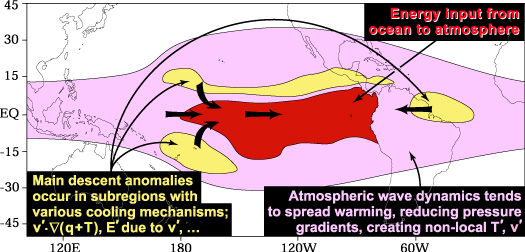BAMS Paper of Note: September 2002
Dry regions during El Niņo
During El Nino, large areas of the equatorial Pacific with enhanced convection experience increased rainfall. In surrounding areas, however, there may be regions of reduced precipitation and anomalous tropospheric descent. The traditional assumption is that this compensating subsidence is caused by radiative cooling due to temperature anomalies in the troposphere. However, it turns out that this radiative cooling is a relatively small effect, on the order of a few W/m2. Instead, stong anomalous descent occurs where larger cooling or drying mechanisms interact with deep convective processes.
We examined the relative contribution of each physical process using moisture and moist static energy budgets of a tropical circulation model forced by the positive sea surface temperature (SST) anomalies in the Pacific observed during the 1997/98 El Niņo. The results were verified for three other El Niņo warm events (1982, 1987, and 1991) and are consistent with additional budget analysis of an atmospheric general circulation model.
An experiment suppressing the radiative cooling due to warm temperature anomalies verifies that this has little impact on the main descent anomalies. Warm tropospheric temperature anomalies are indeed spread over large regions of the tropics by atmospheric waves emanating from the main ENSO region, where heat is carried upward through a deep layer by convection. The widespread temperature anomalies have little direct effect but associated wind and moisture anomalies create cooling and drying tendencies that initiate descent anomalies. Reductions in convective heating and cloud infrared radiative heating enhance this effect, reducing the adiabatic warming associated with descent anomalies. This set of feedbacks can be summarized by an effective moist stability of the tropospheric column, the net result of which is that the descent anomalies are several times larger in regions of climatological moist convection than they would be descending against a dry stability.
The mechanisms initiating descent differ among regions: to the north of the El Niņo warm region, anomalous dry advection dominates, whereas south of the El Niņo warm area a reduction of evaporation is the leading process. The complexity of the mechanisms for the descent anomalies may explain why general circulation models have difficulty simulating and forecasting the descent zone. --Hui Su (University of California, Los Angeles) and J. David Neelin. "Teleconnection Mechanisms For Tropical Pacific Descent Anomalies During El Niņo," appearing in the 15 September Journal of the Atmospheric Sciences.

Associated Paper link:
Su, H., and J. D. Neelin, 2002:
Teleconnection mechanisms for tropical Pacific descent anomalies during El Niņo.
J. Atmos. Sci., 59, 2694-2712.
Paper (PDF 4.5MB)
© Copyright 2002 by the American Meteorological Society.
© Copyright 2002 American Meteorological Society (AMS). Permission to use figures, tables, and brief excerpts from this work in
scientific and educational works is hereby granted provided that the source is acknowledged. Any use of material in this work that is determined
to be "fair use" under Section 107 of the U.S. Copyright Act September 2010 Page 2 or that satisfies the conditions specified in Section 108 of
the U.S. Copyright Act (17 USC §108, as revised by P.L. 94-553) does not require the AMS's permission. Republication, systematic reproduction,
posting in electronic form, such as on a web site or in a searchable database, or other uses of this material, except as exempted by the above
statement, requires written permission or a license from the AMS. Additional details are provided in the AMS Copyright Policy, available on the
AMS Web site located at (http://www.ametsoc.org/) or from the AMS at 617-227-2425 or
copyrights@ametsoc.org.
